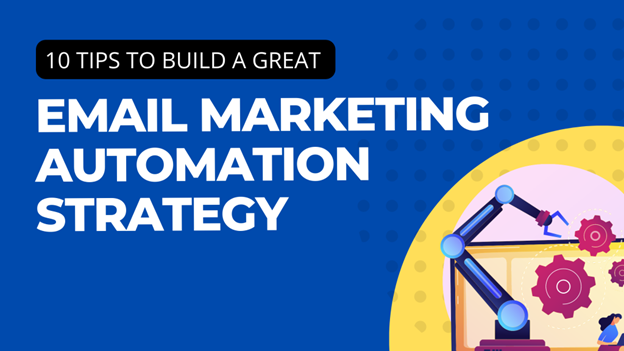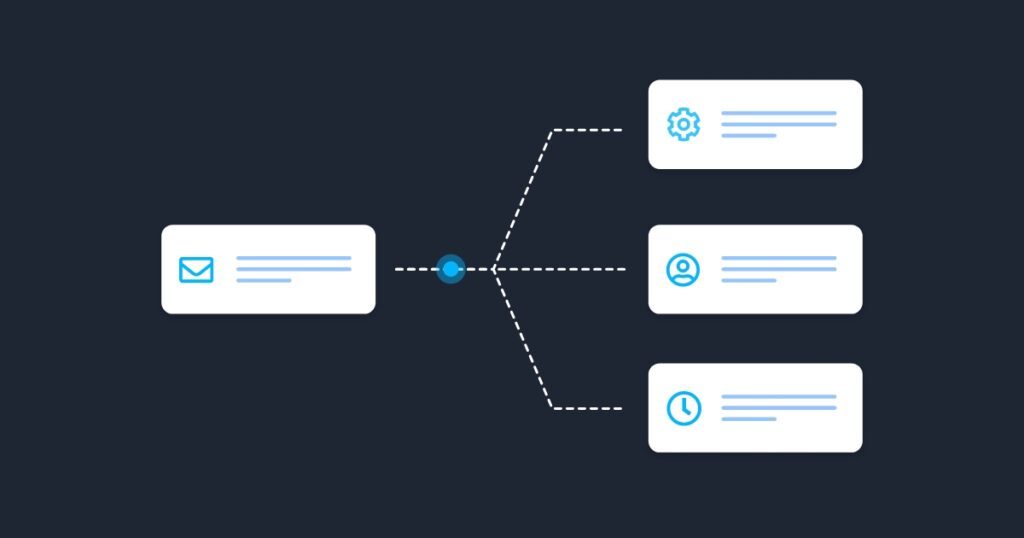Email marketing automation can transform your business. It saves time and boosts engagement.
But how do you start? Developing an email marketing automation strategy can seem daunting. Yet, it’s vital for effective communication and growth. This process involves planning, setting goals, and choosing the right tools. With a clear strategy, you can send personalized emails, nurture leads, and increase sales.
In this blog, we’ll explore how to create a successful email marketing automation strategy. Whether you are new to this or looking to refine your approach, these tips will help you build a strong foundation. Ready to enhance your marketing efforts? Let’s dive in and get started!
Introduction To Email Marketing Automation
Crafting an effective email marketing automation strategy can transform your marketing efforts. It saves time and ensures your messages reach the right audience at the right time. Understanding the basics of email marketing automation can help you build more meaningful connections with your subscribers.
What Is Email Marketing Automation?
Email marketing automation uses software to send emails based on specific triggers or schedules. These triggers can be user actions, like signing up for a newsletter, or specific dates, such as a subscriber’s birthday.
Automated emails can include welcome messages, order confirmations, or re-engagement campaigns. This process helps you maintain regular communication with your audience without manual effort.
Benefits Of Automation In Email Marketing
Implementing email marketing automation comes with several advantages:
- Time-saving: Automation reduces the need for manual tasks, allowing you to focus on other areas of your business.
- Personalization: Automated emails can be tailored to individual subscriber behaviors and preferences.
- Consistency: Ensures your audience receives regular updates and information.
- Improved Engagement: Targeted emails increase open and click-through rates.
Here’s a simple table summarizing these benefits:
| Benefit | Description |
|---|---|
| Time-saving | Reduces the need for manual tasks |
| Personalization | Tailored to subscriber behaviors |
| Consistency | Regular updates and information |
| Improved Engagement | Increases open and click-through rates |
Setting Clear Objectives
Setting clear objectives is crucial for a successful email marketing automation strategy. It helps in guiding your efforts, ensuring you focus on what matters most. Without clear objectives, you may find it hard to measure your success. Let’s dive into how to define your goals and measure success metrics.
Defining Your Goals
Start by identifying what you want to achieve. Goals can range from increasing open rates to boosting sales. Be specific. Clear goals help in creating targeted campaigns. For instance, aim to increase open rates by 20% within three months. This specificity gives direction to your strategy.
Consider your audience’s needs and interests. What do they want from your emails? Understanding this can help in setting realistic and relevant goals. Always align your goals with your overall business objectives. This ensures your email marketing efforts contribute to broader business success.
Measuring Success Metrics
Once you set your goals, decide how to measure success. Key metrics include open rates, click-through rates, and conversion rates. These metrics show how well your emails perform. Open rates indicate the effectiveness of your subject lines. High click-through rates suggest engaging content.
Track these metrics regularly. This allows you to adjust your strategy as needed. Use tools like Google Analytics to monitor your progress. Make sure to analyze the data and make informed decisions. This data-driven approach ensures continuous improvement.
Building Your Email List
Building a successful email marketing strategy starts with creating a strong email list. This list forms the foundation of your campaigns and helps reach your audience effectively. Focusing on growing your subscriber base and segmenting your audience ensures that your messages are relevant and engaging.
Growing Your Subscriber Base
To build a robust email list, you need to attract subscribers. Here are some effective methods:
- Offer Valuable Content: Provide eBooks, guides, or exclusive content in exchange for email sign-ups.
- Use Sign-Up Forms: Place sign-up forms on high-traffic pages of your website.
- Leverage Social Media: Promote your newsletter on social media platforms.
- Run Contests and Giveaways: Encourage people to subscribe for a chance to win prizes.
Segmentation Strategies
Segmenting your email list ensures that your messages are targeted and relevant. Here are some ways to segment your audience:
- Demographics: Group subscribers by age, gender, location, or occupation.
- Behavior: Segment based on past purchase behavior or website interactions.
- Preferences: Allow subscribers to choose the type of content they want to receive.
- Engagement Level: Separate active subscribers from those who are less engaged.
Segmenting helps send personalized content that resonates with each group, improving engagement and conversion rates.
Crafting Effective Email Campaigns
Creating effective email campaigns is essential for any successful email marketing automation strategy. Engaging your audience and delivering value through well-crafted emails can drive higher open rates and conversions. Let’s delve into some key components that can make your email campaigns stand out.
Personalization Techniques
Personalization is crucial in email marketing. It helps build a connection with your audience. Here are some effective techniques:
- Use recipient’s name: Address recipients by their first name to make the email feel personal.
- Segment your audience: Group your audience based on interests, behavior, or demographics to send relevant content.
- Personalized subject lines: Craft subject lines that resonate with the recipient’s interests or past interactions.
- Behavior-based triggers: Send emails based on user actions, such as abandoned carts or past purchases.
Creating Compelling Content
Content is king in email marketing. Your emails should provide value and engage your audience. Here are some tips for creating compelling content:
- Clear and concise messages: Keep your content brief and to the point.
- Engaging visuals: Use images, GIFs, and videos to make your emails visually appealing.
- Strong call-to-action (CTA): Include a clear and compelling CTA that guides the recipient on what to do next.
- Value-driven content: Offer useful information, tips, or resources that benefit your audience.
Below is a table summarizing these points for quick reference:
| Personalization Techniques | Creating Compelling Content |
|---|---|
| Use recipient’s name | Clear and concise messages |
| Segment your audience | Engaging visuals |
| Personalized subject lines | Strong call-to-action |
| Behavior-based triggers | Value-driven content |
Automation Tools And Platforms
Email marketing automation can transform your marketing efforts. Automation tools and platforms simplify the process. They help you reach your audience efficiently. You save time, ensure consistency, and engage your subscribers better. But with many tools available, how do you choose the right one? Let’s explore some of the top email marketing tools and the features you should look for.
Top Email Marketing Tools
Many email marketing tools are available. Some of the most popular include Mailchimp, Constant Contact, and HubSpot. Each tool offers unique features to suit different needs. Mailchimp is known for its user-friendly interface. Constant Contact provides excellent customer support. HubSpot offers a comprehensive marketing suite.
Another popular tool is ActiveCampaign. It excels in advanced automation capabilities. ConvertKit is great for content creators. It simplifies email marketing for bloggers and YouTubers. Campaign Monitor offers beautiful email templates. These templates help create visually appealing emails.
Features To Look For
Choosing the right tool involves looking at specific features. Automation capabilities are crucial. Look for tools that allow easy workflow creation. Drag-and-drop editors make this process simple. Personalization is another key feature. Tools should offer segmentation options. This helps tailor emails to specific audiences.
Analytics and reporting are also vital. Detailed reports help track performance. They show open rates, click-through rates, and conversions. Integration with other platforms is important too. Ensure the tool works well with your CRM or e-commerce platform. Finally, consider customer support. Good support can save time and prevent issues.

Credit: www.omeda.com
Designing Automated Workflows
Designing Automated Workflows is essential for a successful email marketing strategy. It ensures that your messages are timely, relevant, and personalized. Automated workflows help you engage your audience at the right moments. Let’s explore two key types of workflows: Welcome Series and Drip Campaigns.
Welcome Series
A Welcome Series is the first interaction a new subscriber has with your brand. It sets the tone for future communications.
Consider the following steps to create an effective Welcome Series:
- First Email: A warm welcome message introducing your brand.
- Second Email: Share valuable content, like a blog post or video.
- Third Email: Offer a special discount or promotion.
These steps ensure your subscribers feel valued and informed.
Drip Campaigns
Drip Campaigns send emails over a set period. They nurture leads and keep your audience engaged.
Here are some tips for creating effective Drip Campaigns:
- Segment Your Audience: Tailor messages to different groups.
- Set Clear Goals: Know what you want to achieve with each email.
- Measure Performance: Track open rates and click-through rates.
By following these tips, your Drip Campaigns will be more effective and engaging.
Analyzing And Optimizing Campaigns
Creating an effective email marketing automation strategy requires continuous analysis and optimization. Analyzing and optimizing campaigns ensures you achieve the best results. This process helps identify areas for improvement and refine your approach.
Tracking Key Metrics
Tracking key metrics is essential for understanding your campaign’s performance. Metrics like open rates, click-through rates, and conversion rates provide valuable insights. High open rates indicate strong subject lines. Low click-through rates might suggest content improvements. Use these metrics to guide your strategy adjustments.
A/b Testing Strategies
A/B testing strategies allow you to compare different versions of your emails. Test variables like subject lines, images, and call-to-actions. By analyzing results, determine which version performs better. Implement the winning version to enhance your campaign’s effectiveness.

Credit: blog.wishpond.com
Compliance And Best Practices
Creating an effective email marketing automation strategy involves more than just sending emails. Compliance and best practices are crucial. They ensure your emails reach the right audience and avoid legal issues. Following rules and maintaining list health are key parts of this process.
Understanding Gdpr And Can-spam
GDPR and CAN-SPAM are two important regulations for email marketing. GDPR stands for General Data Protection Regulation. It applies to businesses operating in the European Union. GDPR requires explicit consent from users before sending them marketing emails. It also gives users the right to access and delete their data.
CAN-SPAM stands for Controlling the Assault of Non-Solicited Pornography And Marketing. It applies to businesses in the United States. CAN-SPAM requires a clear way to opt-out of emails. It also mandates that the sender’s information is accurate and visible. Both regulations aim to protect user privacy and maintain trust.
Maintaining List Health
Maintaining list health is crucial for a successful email marketing strategy. A healthy email list means engaged subscribers who want to receive your emails. Regularly clean your list by removing inactive subscribers. This improves your open and click rates.
Use double opt-in to ensure subscribers genuinely want your emails. Send a confirmation email after they sign up. This reduces the chances of fake or mistyped email addresses.
Segment your list based on user behavior and preferences. Tailored content keeps subscribers interested. Engaged subscribers lead to better campaign performance and fewer spam complaints.
Case Studies And Examples
Creating an email marketing automation strategy can be challenging. Learning from others can make the process easier. This section looks at case studies and examples. They show how companies succeed with email marketing automation.
Successful Campaigns
One company increased its sales by 30% using email marketing automation. They sent personalized emails based on customer behavior. Customers received special offers on items they viewed but did not buy.
Another company saw a 25% rise in customer engagement. They used automated welcome emails for new subscribers. These emails provided valuable content and offers. The result? More loyal customers.
Lessons Learned
From these case studies, several lessons emerge. First, personalization is key. Tailor your emails to individual customer needs. This increases engagement and sales.
Second, timing matters. Send emails when customers are most likely to read them. This improves open rates and click-through rates.
Third, provide value in every email. Whether it’s a special offer or useful information, ensure your emails benefit the reader. This builds trust and loyalty.
Future Trends In Email Marketing Automation
In the ever-evolving world of digital marketing, staying ahead of trends is essential. Email marketing automation continues to adapt and improve. Businesses need to be aware of the future trends shaping this space. Understanding these trends will help create more effective strategies.
Ai And Machine Learning
Artificial intelligence (AI) and machine learning are transforming email marketing. These technologies analyze vast amounts of data quickly. They identify patterns and preferences. This allows for more personalized emails. AI can automate the process of segmenting audiences. It ensures each recipient gets relevant content. This leads to higher engagement and better results.
Predictive Analytics
Predictive analytics uses historical data to forecast future actions. In email marketing, it helps predict customer behavior. Marketers can tailor their campaigns based on these predictions. This means sending the right email at the right time. Predictive analytics improves open rates and conversions. It helps in understanding what content resonates with your audience.

Credit: zetaglobal.com
Frequently Asked Questions
What Is Email Marketing Automation?
Email marketing automation involves using software to send targeted emails based on user behavior. It helps businesses nurture leads, boost engagement, and increase conversions by automating repetitive tasks.
Why Use Email Marketing Automation?
Email marketing automation saves time, personalizes communication, and improves customer engagement. It helps businesses send timely, relevant messages, leading to higher open rates and better ROI.
How To Start Email Marketing Automation?
To start email marketing automation, choose a reliable platform. Define your goals, segment your audience, and create automated workflows. Test and optimize regularly for best results.
What Are Common Email Automation Workflows?
Common email automation workflows include welcome emails, abandoned cart reminders, and re-engagement campaigns. They help maintain customer relationships and drive conversions.
Conclusion
Crafting an email marketing automation strategy boosts your business efficiency. It saves time and ensures consistent communication with your audience. Start small, test, and refine your approach. Understand your audience’s needs and preferences. Use data to guide your decisions. Stay patient and persistent for the best results.
With these steps, you’ll see improved engagement and customer loyalty. Email marketing automation is a powerful tool. Use it wisely to grow your business effectively. Keep learning and adapting to achieve long-term success.




